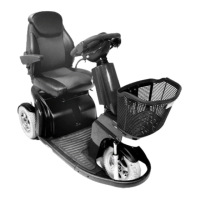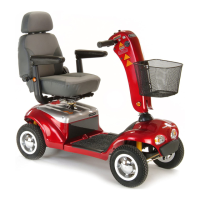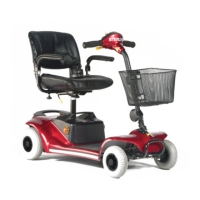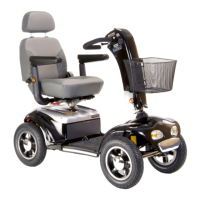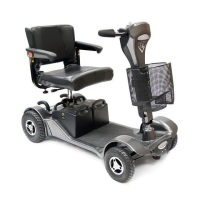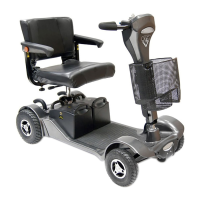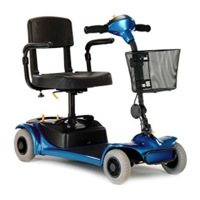Do you have a question about the Sterling Ruby and is the answer not in the manual?
Guidance on selecting the appropriate wheelchair model and safety features based on user needs and environment.
Emphasizes working with professionals to fit the chair and adjust controller settings for user function.
Advises regular reading of the manual and warnings to ensure safe operation.
Explains the meaning of "WARNING" and outlines the four main sections where warnings are located.
Defines electromagnetic interference and its sources, such as radio wave devices.
Details potential effects of EMI on wheelchair operation, including unintended movement and system damage.
Categorizes sources of EMI into hand-held, medium-range mobile, and long-range transceivers.
Explains how EM energy intensity increases with proximity to the source, especially hand-held devices.
Instructs users to promptly report any unintended movement or brake release incidents to Sunrise Medical.
Provides essential safety advice for wheelchair users, including training and hazard awareness.
Offers guidance and safety advice for individuals assisting wheelchair users.
Specifies the maximum weight capacity and consequences of exceeding it, including warranty voidance.
Warns about adjusting controller settings to prevent collisions, falls, or tip-overs.
Outlines pre-use checks for smooth operation, including noise, vibration, and battery status.
Warns against unauthorized modifications, which can void the warranty and create hazards.
Advises turning off power when parked to prevent accidental movement or EMI interference.
Details precautions for use in various environmental conditions and warnings about water exposure.
Specifies suitable terrain for the chair and warns against sand, rough terrain, or loose soil.
Provides safety advice for using the chair in pedestrian areas, emphasizing visibility and driver interaction.
Explains the dangers of transporting the wheelchair in a vehicle and the need for proper restraints.
Discusses factors affecting the chair's center of balance and stability, crucial for preventing tip-overs.
Provides detailed safety instructions for transferring to and from the wheelchair to prevent falls.
Warns about the impact of reaching or leaning on the chair's stability and how to do it safely.
Advises on stable positioning and caster adjustment when dressing or changing clothes.
Details how to navigate common obstacles like thresholds, ramps, and potholes safely.
Offers precautions for driving in reverse, emphasizing slow speed and obstacle awareness.
Explains how slopes affect chair stability and provides warnings about steepness and surface conditions.
Offers critical advice on navigating slopes and ramps, including body positioning and speed control.
Sets minimum safety standards for ramps, including side rails, slope, and surface requirements.
Provides safety guidelines for using wheelchair lifts, including power management and securing the rider.
Warns against exceeding height limits for curbs/steps and potential damage or falls.
Explicitly states that the chair should never be used on stairs due to high risk of falls or tip-overs.
Explicitly states that the chair should never be used on escalators due to high risk of falls or tip-overs.
Clarifies that armrests are not designed for lifting the chair and should not be used for this purpose.
Provides warnings regarding battery case usage, acid spills, and fire hazards.
Discusses the purpose of cushions and advises consulting professionals for pressure sore management.
Warns about using proper high-strength fasteners and the risks of improper tightening.
Advises on proper footplate height and warns against using them for support during transfers.
Explains the operation of motor locks and the safety implications of disengaging them.
Warns against using the ON/OFF switch for emergency stops, recommending joystick use instead.
Provides crucial safety information on the proper and improper use of positioning belts to avoid injury.
Advises consulting suppliers before changing seating systems due to potential impact on balance.
Stresses the importance of maintaining upholstery fabric and warns about potential fire hazards.
Instructs on proper handling of cables and connectors to prevent wire damage.
Provides a step-by-step guide for attendants to safely help a rider ascend a curb or step.
Offers a method for attendants to safely help a rider descend a curb or step.
Lists the basic tool kit and torque wrench required for chair setup, adjustment, and maintenance.
Details the procedure for removing the battery case for transport or servicing, with safety warnings.
Explains how to adjust the footplate angle and warns against opening doors with footplates.
Describes how to connect and disconnect the integral joystick assembly.
Provides instructions for adjusting the width of the armrests and warns of finger pinching.
Explains the backrest angle adjustment mechanism for the High Back Contour Seat.
Details the steps for adjusting the seat height, including pin and set screw adjustments.
Outlines the process for removing and reinstalling the seat, with a safety warning about the lock-out pin.
Advises on final checks after assembly and adjustment, and troubleshooting steps.
Emphasizes matching control settings to user ability and consulting professionals for adjustments.
Explains the thermal roll-back circuit that protects the controller from overheating by reducing motor power.
Describes the function of circuit breakers and how to reset them in case of overload.
Details the components and functions of the integral joystick, including speed control and battery indicator.
Explains how to engage and disengage motor locks for manual pushing and the safety implications.
Introduces battery power for the chair, noting their finite lifespan and charging limits.
Details the function of the battery charger and provides cautions for its use and maintenance.
Warns about handling wet cell batteries, emphasizing precautions against acid spills and eye contact.
Provides safety instructions for handling and connecting batteries, including weight and short-circuit warnings.
Outlines critical safety procedures for charging batteries to prevent electrical shock, fire, or explosion.
Advises on the proper disposal of batteries as hazardous waste and contacting local authorities.
Provides instructions for cleaning the chair's frame, motors, and upholstery to ensure longevity.
Offers advice on storing the chair properly to prevent rust or corrosion and pre-storage checks.
Details essential battery maintenance practices, including handling, corrosion checks, and charging.
Guides on safely repairing or replacing tires on the drive wheels, with specific torque instructions.
Specifies checking motor brushes for wear every four months and replacing them as needed.
Lists the necessary information to provide when ordering replacement parts for the chair.
Presents a chart outlining recommended maintenance checks and their frequency.
Instructs users to fill out and return the guarantee registration card for entitlement.
Outlines the terms and conditions of the manufacturer's warranty, including exclusions and service procedures.
Guidance on selecting the appropriate wheelchair model and safety features based on user needs and environment.
Emphasizes working with professionals to fit the chair and adjust controller settings for user function.
Advises regular reading of the manual and warnings to ensure safe operation.
Explains the meaning of "WARNING" and outlines the four main sections where warnings are located.
Defines electromagnetic interference and its sources, such as radio wave devices.
Details potential effects of EMI on wheelchair operation, including unintended movement and system damage.
Categorizes sources of EMI into hand-held, medium-range mobile, and long-range transceivers.
Explains how EM energy intensity increases with proximity to the source, especially hand-held devices.
Instructs users to promptly report any unintended movement or brake release incidents to Sunrise Medical.
Provides essential safety advice for wheelchair users, including training and hazard awareness.
Offers guidance and safety advice for individuals assisting wheelchair users.
Specifies the maximum weight capacity and consequences of exceeding it, including warranty voidance.
Warns about adjusting controller settings to prevent collisions, falls, or tip-overs.
Outlines pre-use checks for smooth operation, including noise, vibration, and battery status.
Warns against unauthorized modifications, which can void the warranty and create hazards.
Advises turning off power when parked to prevent accidental movement or EMI interference.
Details precautions for use in various environmental conditions and warnings about water exposure.
Specifies suitable terrain for the chair and warns against sand, rough terrain, or loose soil.
Provides safety advice for using the chair in pedestrian areas, emphasizing visibility and driver interaction.
Explains the dangers of transporting the wheelchair in a vehicle and the need for proper restraints.
Discusses factors affecting the chair's center of balance and stability, crucial for preventing tip-overs.
Provides detailed safety instructions for transferring to and from the wheelchair to prevent falls.
Warns about the impact of reaching or leaning on the chair's stability and how to do it safely.
Advises on stable positioning and caster adjustment when dressing or changing clothes.
Details how to navigate common obstacles like thresholds, ramps, and potholes safely.
Offers precautions for driving in reverse, emphasizing slow speed and obstacle awareness.
Explains how slopes affect chair stability and provides warnings about steepness and surface conditions.
Offers critical advice on navigating slopes and ramps, including body positioning and speed control.
Sets minimum safety standards for ramps, including side rails, slope, and surface requirements.
Provides safety guidelines for using wheelchair lifts, including power management and securing the rider.
Warns against exceeding height limits for curbs/steps and potential damage or falls.
Explicitly states that the chair should never be used on stairs due to high risk of falls or tip-overs.
Explicitly states that the chair should never be used on escalators due to high risk of falls or tip-overs.
Clarifies that armrests are not designed for lifting the chair and should not be used for this purpose.
Provides warnings regarding battery case usage, acid spills, and fire hazards.
Discusses the purpose of cushions and advises consulting professionals for pressure sore management.
Warns about using proper high-strength fasteners and the risks of improper tightening.
Advises on proper footplate height and warns against using them for support during transfers.
Explains the operation of motor locks and the safety implications of disengaging them.
Warns against using the ON/OFF switch for emergency stops, recommending joystick use instead.
Provides crucial safety information on the proper and improper use of positioning belts to avoid injury.
Advises consulting suppliers before changing seating systems due to potential impact on balance.
Stresses the importance of maintaining upholstery fabric and warns about potential fire hazards.
Instructs on proper handling of cables and connectors to prevent wire damage.
Provides a step-by-step guide for attendants to safely help a rider ascend a curb or step.
Offers a method for attendants to safely help a rider descend a curb or step.
Lists the basic tool kit and torque wrench required for chair setup, adjustment, and maintenance.
Details the procedure for removing the battery case for transport or servicing, with safety warnings.
Explains how to adjust the footplate angle and warns against opening doors with footplates.
Describes how to connect and disconnect the integral joystick assembly.
Provides instructions for adjusting the width of the armrests and warns of finger pinching.
Explains the backrest angle adjustment mechanism for the High Back Contour Seat.
Details the steps for adjusting the seat height, including pin and set screw adjustments.
Outlines the process for removing and reinstalling the seat, with a safety warning about the lock-out pin.
Advises on final checks after assembly and adjustment, and troubleshooting steps.
Emphasizes matching control settings to user ability and consulting professionals for adjustments.
Explains the thermal roll-back circuit that protects the controller from overheating by reducing motor power.
Describes the function of circuit breakers and how to reset them in case of overload.
Details the components and functions of the integral joystick, including speed control and battery indicator.
Explains how to engage and disengage motor locks for manual pushing and the safety implications.
Introduces battery power for the chair, noting their finite lifespan and charging limits.
Details the function of the battery charger and provides cautions for its use and maintenance.
Warns about handling wet cell batteries, emphasizing precautions against acid spills and eye contact.
Provides safety instructions for handling and connecting batteries, including weight and short-circuit warnings.
Outlines critical safety procedures for charging batteries to prevent electrical shock, fire, or explosion.
Advises on the proper disposal of batteries as hazardous waste and contacting local authorities.
Provides instructions for cleaning the chair's frame, motors, and upholstery to ensure longevity.
Offers advice on storing the chair properly to prevent rust or corrosion and pre-storage checks.
Details essential battery maintenance practices, including handling, corrosion checks, and charging.
Guides on safely repairing or replacing tires on the drive wheels, with specific torque instructions.
Specifies checking motor brushes for wear every four months and replacing them as needed.
Lists the necessary information to provide when ordering replacement parts for the chair.
Presents a chart outlining recommended maintenance checks and their frequency.
Instructs users to fill out and return the guarantee registration card for entitlement.
Outlines the terms and conditions of the manufacturer's warranty, including exclusions and service procedures.
